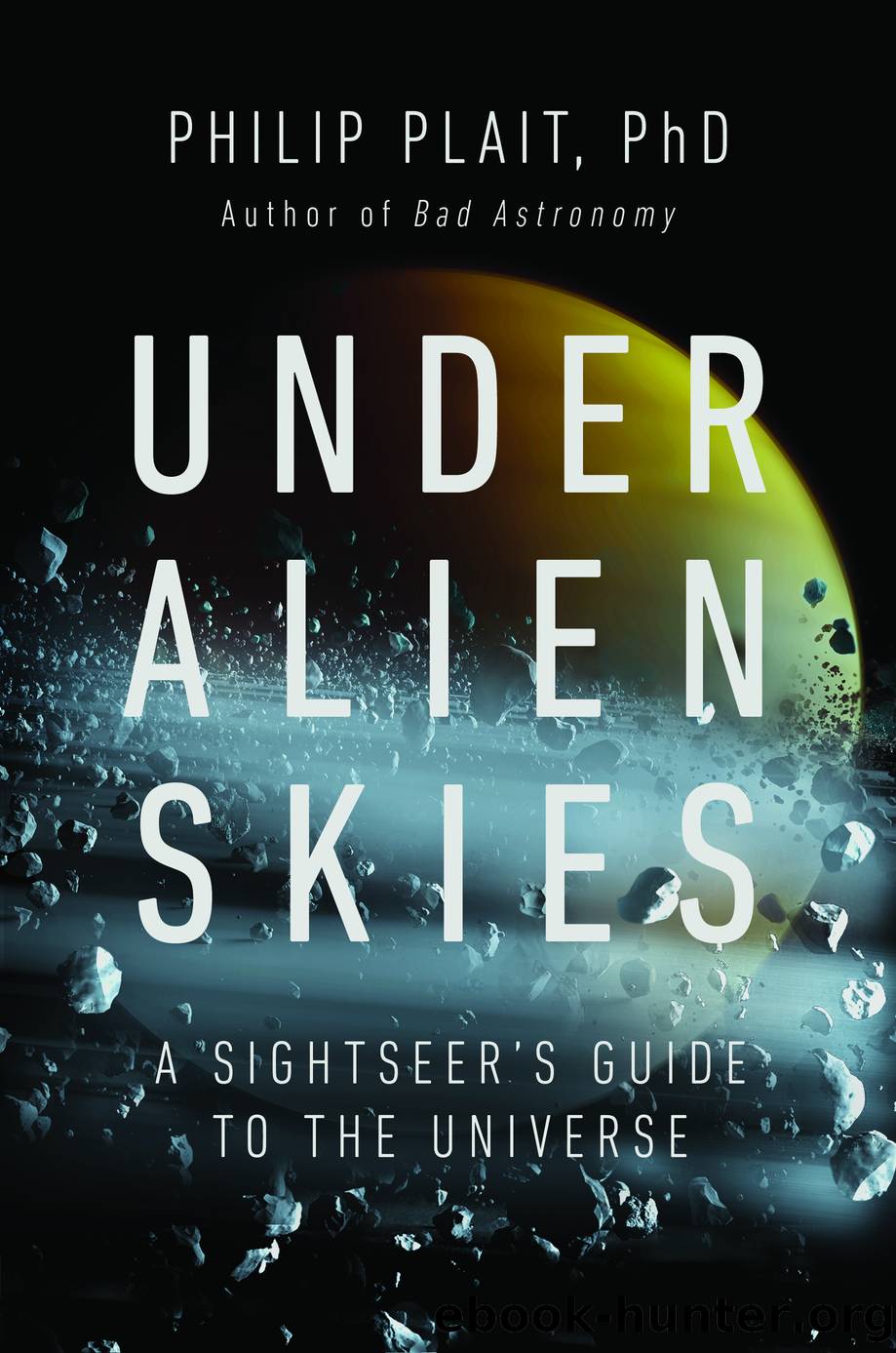Under Alien Skies by Philip Plait

Author:Philip Plait
Language: eng
Format: epub
Publisher: W. W. Norton & Company
Published: 2023-03-09T00:00:00+00:00
TRAPPIST-1E SWELLS IN YOUR VIEWSCREEN, GROWING VISIBLY LARGER every minute.â¡â¡â¡ The planet is impressively bright, given how little light there is to reflect from the host star. The poles of the planet appear redâwater ice reflecting the red dwarfâs lightâbut in a broad band around the equator itâs much darker, almost black. Water reflects red light poorly; thatâs why the wide swath of equatorial ocean is unnervingly dark. The border between the dark ocean and red polar ice is scalloped, sculpted by currents running from the equator to higher latitudes both north and south.
As you approach, you see islands dotting the water, brighter spots in the dark. All are volcanic; the planet is geologically active, squeezed and compressed by gravitational tides from its neighboring planets.§§§ The planets in this system are so tightly packed that the tides they create in each other play an important role in their geology. Planets d and f wreaked havoc on e with the internal heating and strain on the crust their influence generated. Planet e was once phenomenally volcanic, but over the eons, itâs calmed down a bit. Still, some of those islands remain active, pouring lava into the ocean.
The atmosphere is breathable, but only just. Like Earthâs, itâs nitrogen and oxygen, but with a much higher water vapor content. Thatâs good; the water vapor serves to trap the feeble heat from the star, making the planet livable. But itâs also perpetually humid, even downright muggy.
Still, itâs better than planet d, which has no magnetic field and a far thinner atmosphere. Billions of years ago, TRAPPIST-1 was magnetically active, belching out ridiculously powerful stellar flares every few hours. Any planet without a magnetic field was unable to deflect the high-energy particles in the flares and thereby protect its air; over time, its atmosphere was eroded away. The surface of TRAPPIST-1d is barren and dusty, more like Mars than Earth, if Mars averaged over 100°F on its surface.
Planet f is better, somewhat. Its air is breathable but thinner than planet eâs, and with very few greenhouse gases. Itâs cold there, like a Colorado winter even at the equator. Planets b and c are too hot for life like us, while planets g and h are too cold. TRAPPIST-1e is the most Earth-like of the seven (taking a sufficiently broad definition of âEarth-likeâ).
As your ship slips around to the dark side of the planet, you spot the lights of a small base down near the water. Itâs too dark to make anything else out, but you read in your guide that the base is built into the side of a volcanic caldera, part of an archipelago. You know that if you could see the ocean, it would be whipped up into a froth due to the ever-present winds. Time to strap in. The landing will be bumpy.
Download
This site does not store any files on its server. We only index and link to content provided by other sites. Please contact the content providers to delete copyright contents if any and email us, we'll remove relevant links or contents immediately.
| Aeronautics & Astronautics | Astronomy |
| Astrophysics & Space Science | Comets, Meteors & Asteroids |
| Cosmology | Mars |
| Solar System | Star-Gazing |
| Telescopes | UFOs |
Tools of Titans by Timothy Ferriss(8222)
Turbulence by E. J. Noyes(7942)
Secrets of Antigravity Propulsion: Tesla, UFOs, and Classified Aerospace Technology by Ph.D. Paul A. Laviolette(5310)
Astrophysics for People in a Hurry by Neil DeGrasse Tyson(5134)
Room 212 by Kate Stewart(5040)
Design of Trajectory Optimization Approach for Space Maneuver Vehicle Skip Entry Problems by Runqi Chai & Al Savvaris & Antonios Tsourdos & Senchun Chai(5011)
Pale Blue Dot by Carl Sagan(4913)
The David Icke Guide to the Global Conspiracy (and how to end it) by David Icke(4628)
A Journey Through Divination and Astronomy by Publishing Pottermore(4344)
Goodbye Paradise(3729)
Apollo 8 by Jeffrey Kluger(3637)
COSMOS by Carl Sagan(3559)
Losing the Nobel Prize by Brian Keating(3499)
The Five People You Meet in Heaven by Mitch Albom(3476)
How to Read Water: Clues and Patterns from Puddles to the Sea (Natural Navigation) by Tristan Gooley(3409)
Brief Answers to the Big Questions by Stephen Hawking(3369)
How to Read Nature by Tristan Gooley(3250)
The Order of Time by Carlo Rovelli(3145)
A Brief History of Time by Stephen Hawking(2962)
